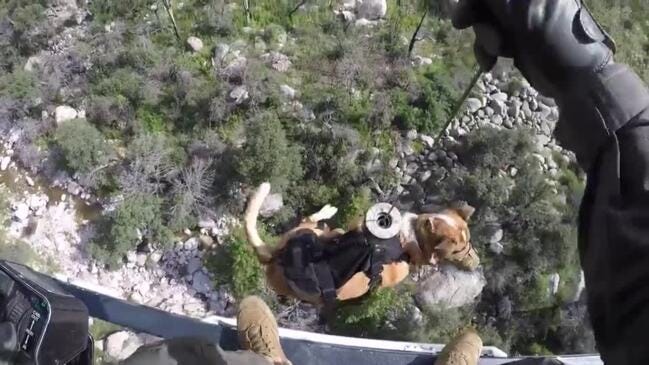1. A California family says they're thrilled after their deaf dog was rescued by emergency responders after falling 100 feet down a ravine. "It was a miracle," Julia Plant told CNN affiliate KGTV, after Hobo, an 8-year-old Australian shepherd, was rescued. Plant was walking Hobo near their Sorrento Valley home when he darted after something in the ravine, lost his footing and tumbled into the brush far below. Members of the San Diego Humane Society's Emergency Response Team rushed to the scene, where they realized they would need to rappel down the ravine to reach the dog. It took five people a total of four hours to rescue Hobo. (via CNN)
2. Ivana Stradner opened her iPhone and typed a simple call-to-arms: Unleash the hounds. A Washington think-tanker and an expert in Russian propaganda, Stradner is also a member of NAFO — or the North Atlantic Fellas Organization — an informal alliance of internet culture warriors, national security experts and ordinary Twitter users weaponizing memes, viral videos and, yes, dog photos to push back against Russian online disinformation. The group — which includes ordinary foot soldiers like Stradner, as well as political heavyweights like U.S. Congressman Adam Kinzinger, former Estonian President Toomas Hendrik Ilves and, as of this week, Ukraine’s Defense Minister Oleksii Reznikov — uses as its weapon of choice a badly-drawn image of Shiba Inu, the Japanese dog breed that became an internet sensation a decade ago and is referred to as a “doge” in internet culture. (via Politico)
3. The best dogs in bear hunting come from avid European houndsmen, dating back to the 1750s and 1800s. Bear hunting with hounds found its place in North America during the Colonial period, but has reached its stride in more modern times as new hunting dog breeds were established in the early 1900s. Over the decades, one thing has stayed the same: Houndsmen are loyal to their chosen breed of bear dog. There’s no worse offense in their world than disparaging a man’s dog. Do it, and they will run you right off the mountain. But what breeds make up this short list of best bear dogs? If you’re just getting into bear hunting, it’s likely you are unfamiliar with many of them. What you will find is that the best bear dogs are highly driven, accomplished trackers, and tenacious. (via Outdoor Life)
4. The Humane Society of the United States has completed its historic mission to remove nearly 4,000 beagles from a mass breeding facility which bred dogs to be sold to laboratories for animal experimentation. The last group of 312 beagles was removed from the facility earlier today and of that, 52 are en route to the Humane Society of the United States’ care center. In the coming days, they will be transported to independent shelter and rescue partners to find loving homes. (via Humane Society)
5. A decades-old ban on pit bulls in Prince George’s County is being challenged in federal court through a class-action lawsuit calling the ordinance vague and discriminatory. The county’s policy, which has been on the books since 1997, applies to dogs that are at least 50 percent pit bull — which is not a breed but a category of dog that includes American pit bull terriers and Staffordshire bull terriers. The lawsuit, filed in July, claims that the county’s pit bull ordinance is unconstitutionally vague and overbroad, not based in science, and encourages “seriously discriminatory enforcement.” The suit also alleges that the ban violates the Fair Housing Act by forcing residents to either give up their dogs or move outside Prince George’s County. (via The Washington Post)
6. Dogs are rarely "nice" or "nasty." People tend to label some dog breeds as aggressive and some, such as the pit bull terrier, are often banned, yet all dogs have the potential to bite. In fact, banned breeds are no more likely to bite than other breeds, despite a reputation for being more aggressive. There is little evidence breed-specific laws reduce biting. Labrador retrievers, one of the most popular dog breeds in the U.K. often feature in lists and reports about aggressive dog breeds.. This likely because Labradors make up such a high proportion of the dog population. But it also highlights why we should be aware of our interactions around all dogs, no matter the breed. Biting is not inevitable. Understanding the reasons why dogs bite is the key to prevention. (via Physical Org, Irish Vet Journal, Science Direct, Metro News)
7. There’s a growing interest these days in the health benefits of dogs. Therapy dogs can do more than fetch, roll over, and stay - they have been proven to provide relief to those in anxiety-provoking situations, bring comfort to those who are grieving or lonely, and offer affection to patients in hospitals, nursing homes, etc. Canada thought that perhaps her dog, Nash, could become a therapy dog, but needed more information to see if it would be possible. She was ecstatic to find that her professor at USU, Air Force Lt. Col. Regina Owen, program director and chair of the PMHNP program, utilized therapy dogs in a clinical setting when working with trauma patients, and was more than willing to share her practical experience. (via Uniformed Services Academy)
8. The pandemic gave people a lot more time with their dogs and cats, but return to the office has disrupted that connection. Pet cameras can help but are needed in every room and don't really tell owners what their furry friend has been up to without reviewing all footage. Now, researchers at the Georgia Institute of Technology have created a new device that can put pet owners at ease. PetTrack uses a combination of sensors to give the accurate, real-time indoor location of an animal. Ultra-wideband (UWB) radio wireless sensors locate the pet and accelerometers determine if it's sitting or moving regardless of objects or walls in the way, giving owners more detail on what their pet is doing than a camera or GPS. All of this is located on a small sensor that can be put on a collar for minimal invasiveness and can be viewed via a compatible smartphone app. (via Science Daily)
9. Classical music may help dogs settle when they are home alone, but playing audiobooks has no effect. That is according to a just-published research paper from academics at Queen's University in Belfast (QUB). The study found that playing classical music had a "moderately-calming effect" when separated from their owners. However, it ultimately found that music and audiobooks have "little value to dogs in situations of short-term acute stress”. Previous Scottish research suggested that classical music had a calming effect on dogs in rescue kennels. Subsequent research suggested that dogs particularly preferred listening to reggae and soft rock. (via BBC)
Bonus! Dolly Parton, who is beloved not just for her legendary country music but for her compassion and generosity, has launched a pet clothing and accessories line that she says will help support an animal rescue organization. The line, appropriately called Doggy Parton, features fringe-trimmed cowgirl dresses, rhinestone-bejeweled harnesses, gingham shirts and bandanas, concert T-shirts, toys and even a blond wig inspired by the singer. (via National Public Radio)
Dog Photo of the Week
Photo by Matt Growcoot, “Centuries Old Photographs Show Our Immortal Love of Dogs” (via PetaPixel)
Dog Video of the Week
By TedX, “How Dogs Love Us”.




